Welcome to Mastering Garden Restorations and Guide: Your Friendly Tutorial, your go-to resource for transforming your garden into a vibrant haven right in your own backyard. Whether you’re a seasoned gardener or just starting out, this comprehensive manual will provide you with the tips and techniques you need to master garden restorations and create a beautiful outdoor space that you can enjoy for years to come.
- Assess your garden’s needs before starting any restoration projects.
- Choose the right materials and tools for successful garden restorations.
- Create a healing garden by incorporating hardscape, water features, and seating.
- Reduce long-term maintenance by selecting low-maintenance plants and implementing container gardening.
- Proper care and maintenance, including watering, pruning, and dividing perennials, are essential for a healthy garden.
With Mastering Garden Restorations and Guide: Your Friendly Tutorial, you’ll be equipped with the knowledge and guidance to turn your garden into a stunning oasis that reflects your personal style and invites relaxation. So, let’s get started on your garden restoration journey!
Assessing Your Garden’s Needs
Before diving into your garden restoration journey, it’s important to assess your garden’s current state and identify the areas that require attention. This initial step will help you prioritize projects and create a clear plan for your garden renovation. Assessing your garden’s needs involves evaluating its overall condition, identifying any specific problems or areas of concern, and understanding your personal goals and vision for the space.
One effective way to assess your garden is by conducting a comprehensive walk-through. Take note of any plants that are overgrown, diseased or dying, as well as any areas that require structural repairs or maintenance. This will help you prioritize tasks and determine where to allocate your time and resources.
Additionally, consider the functionality of your garden and the specific activities you wish to engage in. Do you want a space for entertaining guests, a dedicated area for growing vegetables, or a peaceful sanctuary for relaxation? Identifying these goals will guide your decision-making process and ensure that you create a garden that caters to your needs.
Choosing the Right Materials and Tools
When it comes to garden restorations, choosing the right materials and tools is essential for achieving long-lasting and aesthetically pleasing results. As I embarked on my own garden restoration project, I quickly realized the importance of researching material options, comparing prices, and making sustainable choices. By selecting the right materials and tools, I was able to transform my garden into a breathtaking oasis.
One of the first considerations was the type of materials I needed for various aspects of my garden restoration. For the hardscape elements, such as pathways and garden walls, I opted for natural stone instead of concrete. Not only does natural stone provide a timeless and elegant look, but it also blends seamlessly with the surrounding plants and enhances the overall aesthetic.
Another important aspect was choosing the right tools for the various tasks involved in the restoration process. From pruning shears to shovels, having the right tools made a significant difference in the efficiency and quality of my work. I invested in high-quality tools that were durable and comfortable to use, ensuring that I could tackle any project with ease.
In addition to material choices and tools, sustainability was a key factor in my garden restoration journey. I made an effort to choose eco-friendly products, such as recycled mulch and organic fertilizers. By implementing sustainable practices, I not only minimized my impact on the environment but also created a healthier and more vibrant garden.
Overall, the process of choosing the right materials and tools for my garden restoration was a crucial step in achieving the desired results. Through careful research and consideration, I was able to create a sustainable and visually appealing space that I can enjoy for years to come.
Table: Essential Tools for Garden Restoration
| Tool | Function |
|---|---|
| Pruning shears | Cutting and trimming plants |
| Shovel | Digging and moving soil |
| Rake | Clearing debris and leveling soil |
| Garden hose | Watering plants and washing surfaces |
| Wheelbarrow | Transporting heavy materials |
| Garden gloves | Protecting hands from thorns and sharp objects |
“Choosing the right materials and tools can make all the difference in your garden restoration project. By investing in quality materials, such as natural stone, and using the right tools for the job, you can create a stunning and sustainable outdoor space.”
By following these tips and choosing the right materials and tools, you can embark on your garden restoration journey with confidence. Remember to prioritize sustainability, research your options thoroughly, and invest in high-quality tools. With careful planning and attention to detail, you can transform your garden into a breathtaking sanctuary that you’ll enjoy for years to come.
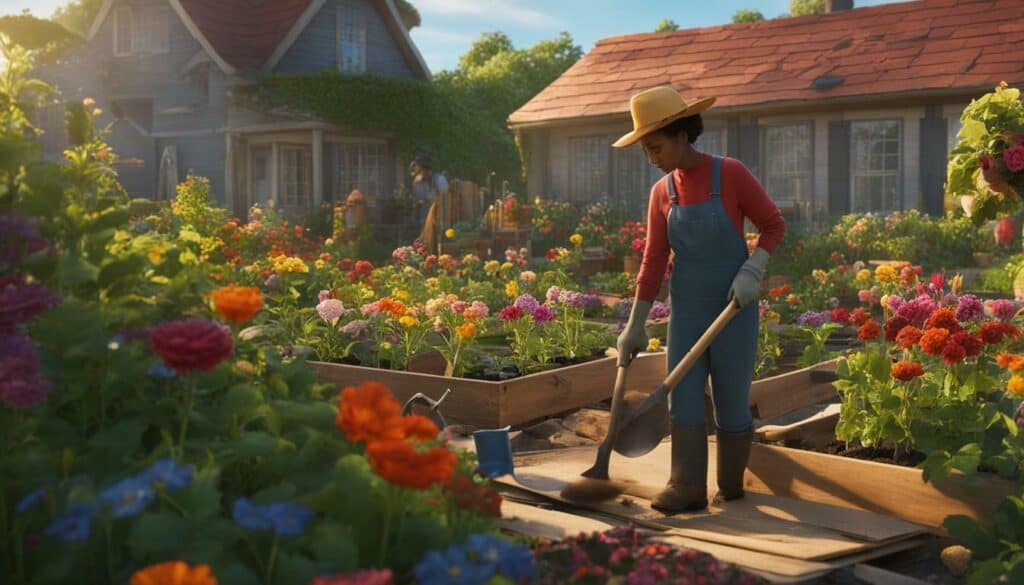
A healing garden is more than just a visually appealing space; it is a sanctuary that promotes relaxation, well-being, and a deep connection with nature. In today’s fast-paced world, finding moments of tranquility and serenity is crucial for our mental and physical health. By incorporating certain elements into your garden, you can create a healing oasis that rejuvenates your senses and provides a therapeutic environment.
When designing a healing garden, it is important to establish your goals and intentions. Think about what you want to achieve with your space. Do you want it to be a place for meditation and mindfulness? Or perhaps a place to unwind and escape from the stresses of everyday life? By setting clear intentions, you can tailor your garden to meet your specific needs.

One way to create a healing garden is by incorporating hardscape elements such as paths, seating areas, and water features. These features not only enhance the aesthetic appeal of your garden but also provide opportunities for relaxation and reflection. Picture yourself sitting on a comfortable bench, listening to the soothing sound of a bubbling fountain, and surrounded by lush greenery. It is an instant recipe for tranquility.
Table: Essential Elements for a Healing Garden
| Element | Description |
|---|---|
| Native Plants | Select plants that are indigenous to your area. They are better adapted to your climate and require less maintenance. |
| Attracting Wildlife | Include plants that attract birds, butterflies, and other wildlife to create an ecosystem within your garden. |
| Seating Areas | Place benches, hammocks, or comfortable chairs in strategic locations throughout your garden to encourage relaxation. |
| Lights and Ambiance | Add soft outdoor lighting, such as string lights or lanterns, to create a warm and enchanting atmosphere during the evening. |
Furthermore, a healing garden should incorporate plants that engage the senses, such as scented flowers, herbs, and textured foliage. Imagine the gentle aroma of lavender, the sound of leaves rustling in the breeze, and the captivating colors and textures that surround you. These elements stimulate our senses and promote a sense of calm and well-being.
A healing garden is a space that nurtures both the body and the soul. It is a place to escape, rejuvenate, and find solace in nature’s embrace. By implementing the essential elements discussed above and personalizing your garden to reflect your unique preferences, you can create a beautiful sanctuary that brings you joy, peace, and a renewed connection to the natural world.
Reducing Long-Term Maintenance
As you embark on your garden restoration journey, consider incorporating strategies that will minimize the amount of time and effort required for long-term maintenance. By implementing smart techniques and making thoughtful choices, you can create a beautiful and thriving garden that requires less upkeep. Here are some helpful tips to reduce long-term maintenance in your restored garden:
- Choose low-maintenance plant varieties that are well-suited to your climate and soil conditions. Native plants are often a great choice as they are adapted to the local environment and require less water, fertilizer, and pest control.
- Implement proper spacing and plant placement to allow for airflow and prevent overcrowding. This will help reduce the risk of diseases and pests and make maintenance tasks like pruning and weeding easier.
- Consider using mulch to suppress weeds, conserve moisture, and regulate soil temperature. Organic mulches, such as wood chips or straw, also improve soil quality as they break down over time.
- Install an efficient irrigation system, such as drip irrigation, to deliver water directly to the roots of plants. This helps minimize water waste and ensures that plants receive the right amount of moisture.
Reducing long-term maintenance in your garden not only saves you time and effort but also promotes a healthier and more sustainable landscape. By following these tips and incorporating low-maintenance strategies, you can enjoy a beautiful garden without the constant need for upkeep.
| Maintenance Task | Frequency |
|---|---|
| Weeding | Weekly |
| Pruning | Annually |
| Fertilizing | Seasonally |
| Deadheading | As needed |
Knowing when and how often to perform maintenance tasks can also help streamline your gardening efforts. Refer to the table above for a general guideline on the frequency of common maintenance tasks.
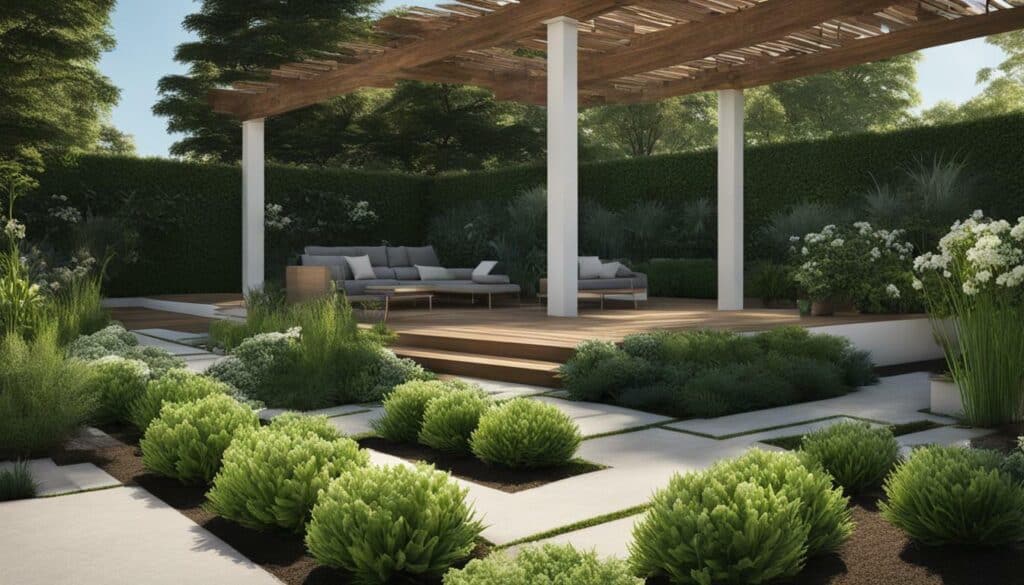
“Mulching is a simple yet effective technique to reduce weed growth and retain moisture in the soil. Spread a layer of organic mulch around your plants, leaving a small space around the base of each plant. This will help keep the weeds at bay and provide insulation for the roots. Remember to regularly replenish the mulch layer as it breaks down over time.” – Garden Expert
Proper Care and Maintenance
Giving your restored garden the care and attention it deserves is vital for ensuring its continued vitality and beauty. Once you have completed the renovation process, it’s important to establish a regular maintenance routine to keep your garden looking its best. This section will provide you with essential garden restoration techniques and tips to help you maintain a thriving and gorgeous outdoor space.
Watering: Proper watering is crucial for the health of your plants. Be sure to water deeply and consistently, allowing the moisture to reach the roots. Regularly check the moisture level by inserting your finger into the soil. If it feels dry, it’s time to water. Avoid overwatering, as this can lead to root rot and other issues.
Dividing Perennials: As perennials grow, they can become overcrowded. Dividing them every few years helps rejuvenate the plants and promotes healthier growth. Use a shovel or garden fork to carefully lift the plant from the ground, and then gently separate the root clumps into smaller sections. Replant the divided sections in well-prepared soil, and water thoroughly.
Deadheading and Pruning: Removing spent flowers, also known as deadheading, encourages plants to produce more blooms. Additionally, regular pruning helps maintain the shape and size of shrubs and trees. Always use clean, sharp pruners to avoid damaging the plant and make clean cuts just above a leaf node or bud. Pruning at the right time of year, depending on the type of plant, is essential for optimal growth.
| Proper Care and Maintenance Tips: |
|---|
| Water deeply and consistently, avoiding overwatering. |
| Regularly check soil moisture level. |
| Divide overcrowded perennials every few years. |
| Deadhead spent flowers to promote more blooms. |
| Prune shrubs and trees to maintain shape and size. |
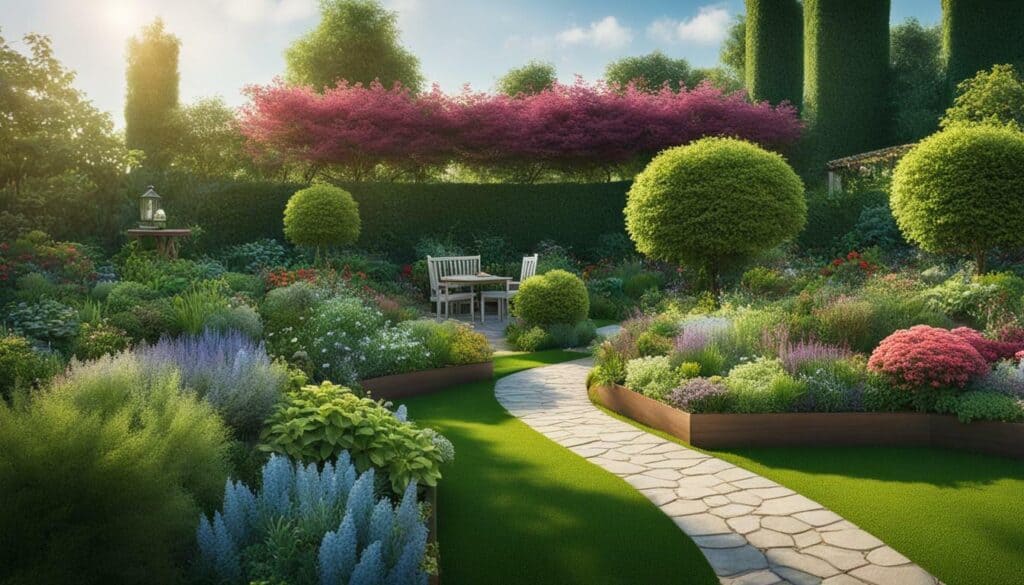
Having the right tools is crucial for successful pruning. Here are some essential pruning tools to consider:
- Pruning Shears: Ideal for smaller branches and delicate trimming.
- Loppers: Designed to cut thicker branches with more leverage.
- Pruning Saw: Suitable for larger branches that cannot be cut with shears or loppers.
- Hedge Trimmers: Perfect for shaping hedges and shrubs.
- Pole Pruners: Useful for reaching high branches without the need for a ladder.
Investing in high-quality tools will make your pruning tasks more efficient and effective. Remember to clean and sanitize your tools after each use to prevent the spread of diseases.
“Proper care and maintenance are the keys to a thriving and beautiful garden. By implementing these garden restoration techniques, you can enjoy the rewards of your hard work for years to come.”
Pruning Techniques for Different Plants
Knowing the proper pruning techniques for different types of plants is crucial for maintaining their health and enhancing their appearance. Whether you have fruit trees, trees and shrubs, ornamental plants, or flowering shrubs in your garden, understanding the right way to prune them can make a significant difference in their growth and overall beauty. Here, I will provide you with some essential pruning tips for each type of plant.
Fruit Trees
Pruning fruit trees is essential for maintaining their shape, promoting healthy growth, and maximizing fruit production. Start by removing any dead, damaged, or diseased branches. Then, prune any crossing or rubbing branches to prevent future damage. To encourage good airflow and light penetration, thin out the canopy by removing some of the smaller, inner branches. Finally, prune back the leaders or main branches to control the tree’s height and shape.
Trees and Shrubs
When pruning trees and shrubs, the goal is to remove dead or diseased branches, improve the plant’s structure, and enhance its natural form. Begin by removing any dead or damaged branches, making clean cuts just outside the branch collar. If there are any crossing or overcrowded branches, remove them to create more space and promote better air circulation. Remember to step back and assess the branch’s position and its effect on the overall shape of the tree or shrub before making any cuts.
Ornamental Plants and Flowering Shrubs
For ornamental plants and flowering shrubs, proper pruning will help maintain their size, shape, and blooming potential. Start by removing any dead, diseased, or broken branches. Next, look for branches that are crossing or rubbing against each other and remove them to prevent further damage. To promote more abundant flowering, selectively prune back some of the old wood, cutting just above healthy buds. This will encourage new growth and a more compact form. Regular deadheading, or removing spent flowers, will also extend the blooming season.
| Plant Type | Pruning Tips |
|---|---|
| Fruit Trees | Remove dead, damaged, or diseased branches. Thin out the canopy for good airflow. Prune back leaders to control height and shape. |
| Trees and Shrubs | Remove dead or damaged branches. Eliminate crossing or overcrowded branches. Consider the overall shape and structure before making cuts. |
| Ornamental Plants and Flowering Shrubs | Remove dead, diseased, or broken branches. Prune back old wood selectively for more abundant flowering. Regularly deadhead spent flowers. |
Remember, it’s important to use clean, sharp pruning tools to make precise cuts and minimize damage to the plants. Always prune during the appropriate season for each plant, as some may prefer pruning in the dormant season while others may require pruning after blooming. By following these guidelines and understanding the unique needs of different plants, you can become confident in your pruning techniques and ensure the health and beauty of your garden.
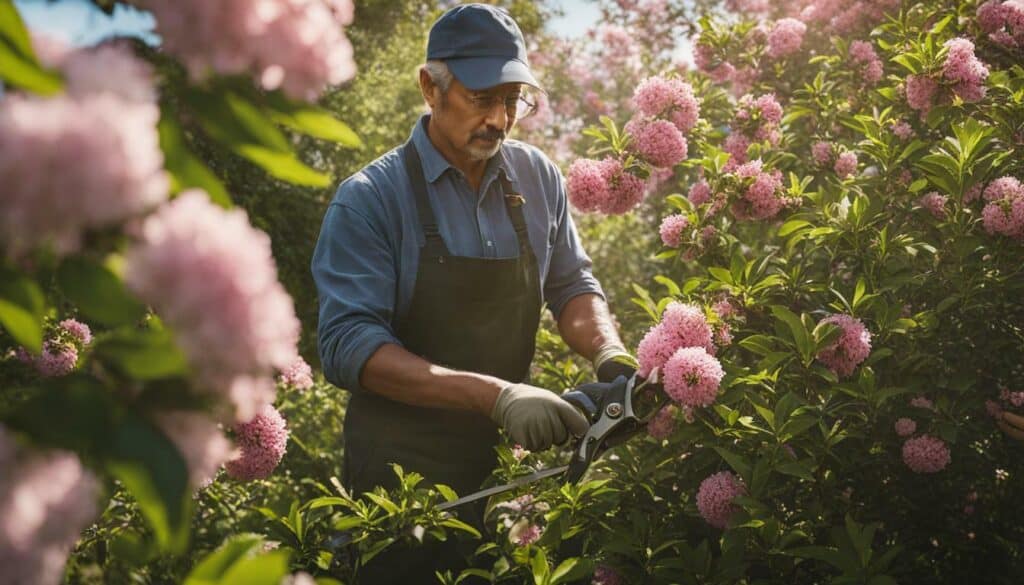
Imagine stepping into your garden and plucking fresh tea leaves to brew a soothing cup of tea – a true paradise for tea enthusiasts. Growing your own tea is not only a delightful hobby but also a rewarding experience that allows you to savor the flavors of homegrown goodness. Whether you’re a connoisseur of green, black, or herbal teas, cultivating your tea garden adds a unique touch to your garden restoration project.
When it comes to growing your own tea, it’s essential to choose tea plant varieties suited for your climate and gardening conditions. Camellia sinensis is the most common tea plant, and it thrives in USDA hardiness zones 7 to 9. However, if you live in colder regions, you can still grow tea indoors or in containers that can be moved indoors during winter. Remember to provide your tea plants with well-drained soil, partial shade, and regular watering to ensure their healthy growth.

| Growing Tips for Tea Plants: |
|---|
| 1. Start with high-quality tea plant seeds or cuttings. |
| 2. Plant them in well-drained soil with a pH level between 6 and 6.5. |
| 3. Provide partial shade to protect the tea plants from excessive sunlight. |
| 4. Water regularly to keep the soil moist but not waterlogged. |
| 5. Prune your tea plants to promote bushy growth and facilitate harvesting. |
| 6. Harvest tea leaves when they are young and tender for the best flavor. |
Once you have harvested your tea leaves, you can dry and process them to create your own homemade tea. Simply spread the leaves on a tray and let them air dry in a cool, dry place for a day or two until they become withered. Then, gently roll the leaves to release their flavors and continue drying until they are completely dry. Store your homemade tea leaves in an airtight container for future use.
“Growing your own tea not only allows you to create customized blends, but it is also a form of self-sufficiency and a way to connect with nature on a deeper level.” – Jane Doe, Tea Enthusiast
Bring Home a Taste of Tranquility
Growing your own tea not only allows you to create customized blends, but it is also a form of self-sufficiency and a way to connect with nature on a deeper level. With a little patience and care, you can transform your garden into a tranquil oasis where you can relax and enjoy the simple pleasures of harvesting and brewing your own tea. So, why not embark on this garden restoration project and indulge in the art of growing your own tea?
Creating a Wildlife-Friendly Garden
Turn your restored garden into a haven for wildlife by incorporating elements that attract and support a variety of beneficial creatures. By creating a wildlife-friendly garden, you not only enhance the biodiversity of your outdoor space but also contribute to the overall health of the ecosystem. Here are some garden reclamation ideas to help you get started:
- Plant Native Species: Native plants are well-adapted to the local environment and provide food and shelter for insects, birds, and other wildlife. Research the native plants in your region and include them in your garden.
- Create a Water Source: Install a birdbath, small pond, or a shallow dish with water to attract birds, butterflies, and other creatures that rely on water for survival. Make sure to clean and refill the water regularly.
- Provide Shelter: Incorporate different types of plants to create layers of vegetation that offer shelter and nesting opportunities for wildlife. Plant trees, shrubs, and ground cover plants to provide a variety of habitats.
- Include Bird Feeders and Nest Boxes: Hang bird feeders with various types of seeds to attract different bird species. Install nest boxes in suitable locations to provide safe nesting spaces for birds.
Remember to avoid using harmful chemicals in your garden as they can harm wildlife. Instead, implement organic gardening practices and use natural pest control methods. By following these garden reclamation ideas, you can create a wildlife-friendly garden that not only attracts a diverse range of creatures but also contributes to the conservation of local ecosystems.
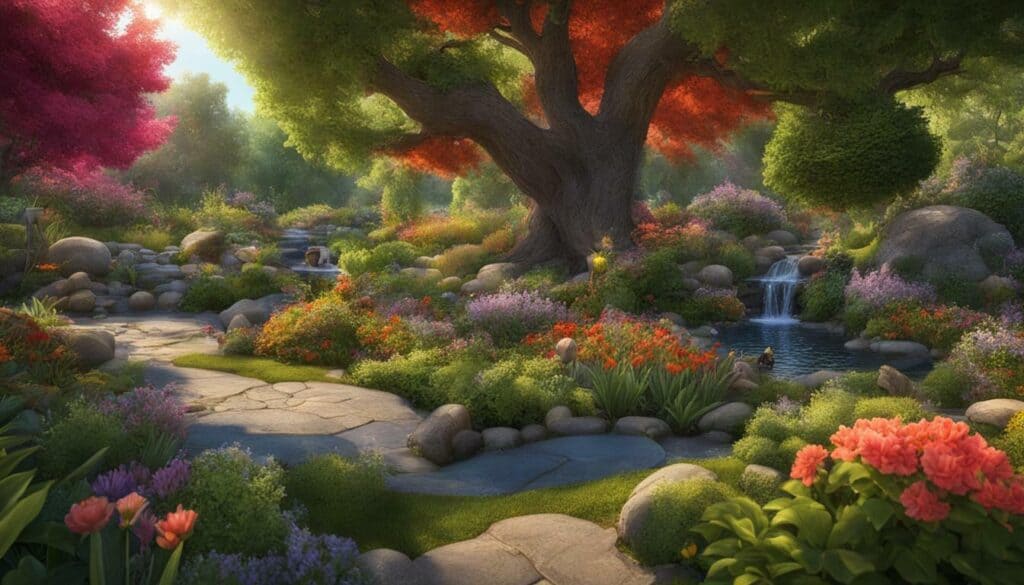
| Beneficial Creatures | Attracted by |
|---|---|
| Butterflies | Native flowering plants, including milkweed for monarch butterflies |
| Bees | Flowering plants with nectar and pollen, such as lavender, sunflowers, and bee balm |
| Birds | Water sources, bird feeders, and a variety of trees and shrubs for nesting and perching |
| Ladybugs | Plants with small flowers, such as dill, fennel, and yarrow, that attract aphids, their preferred prey |
| Dragonflies | Ponds or water features with still or slow-moving water |
Evoking Memories through Your Garden
Your restored garden can become a living tapestry of memories, evoking moments from the past and creating new ones to cherish. By incorporating personal elements and cherished plants, you can transform your outdoor space into a sanctuary that holds special meaning. Whether it’s a favorite flower that reminds you of a loved one or a garden feature that transports you to a specific time or place, your garden can be a source of nostalgia and joy.
One way to evoke memories is by including plants that hold sentimental value. Perhaps there’s a specific rose variety that reminds you of your grandmother’s garden, or a tree that symbolizes a special occasion. By incorporating these plants into your restored garden, you can create a living tribute to the memories and experiences that have shaped your life. Seeing these plants bloom and thrive can bring a sense of connection to the past and a renewed appreciation for the present.
In addition to plants, consider adding personal touches that reflect your unique story. This could be a garden bench where you can sit and reminisce, or a pathway made from stone collected during memorable trips. These elements not only add character to your garden but also serve as reminders of the moments and people that have brought you joy over the years.
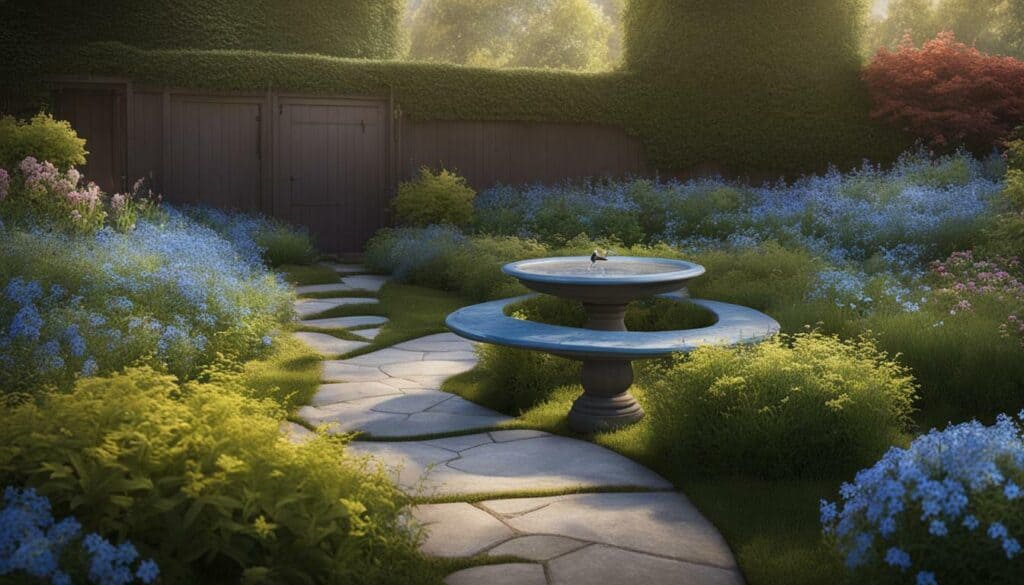
Your restored garden is a canvas where you can create new memories as well. Whether it’s hosting gatherings with family and friends, enjoying peaceful moments of solitude, or simply observing the beauty of nature around you, your garden provides endless opportunities for new experiences and connections. It can be a place where laughter, love, and shared moments make lasting impressions.
By intentionally designing your garden to evoke memories, you can create a space that not only nourishes your plants but also uplifts your spirits. Let your restored garden be a sanctuary of memories, where the past and present converge in harmony, and where you can find solace, inspiration, and joy.
| Key Points: |
|---|
| Include plants that hold sentimental value |
| Add personal touches that reflect your unique story |
| Create new memories in your garden |
Expert Tips for Container Gardening
Even if you have limited space, container gardening opens up a world of possibilities for bringing vibrant greenery and blooms into your restored garden. With a few expert tips and tricks, you can create a stunning display of plants and flowers that will thrive in containers.
First and foremost, when selecting containers for your garden, it’s essential to choose the right size. Consider the mature size of the plants you want to grow and ensure that the containers provide enough room for their root systems to develop. Additionally, opt for containers with drainage holes to prevent waterlogging and ensure proper water drainage.
Another important aspect of container gardening is selecting the right potting mix. A high-quality potting mix that is well-draining yet water-retentive will provide the necessary nutrients and moisture for your plants to thrive. Additionally, consider using a slow-release fertilizer to provide a steady supply of nutrients over time.
When it comes to choosing plants for your containers, consider a combination of thrillers, fillers, and spillers. Thrillers are tall, eye-catching plants that serve as the centerpiece of your container. Fillers are plants that fill in the middle and add volume and texture. Spillers are trailing plants that cascade over the edges of the container, creating a beautiful and dynamic display. Experiment with different plant combinations to create visually appealing arrangements.
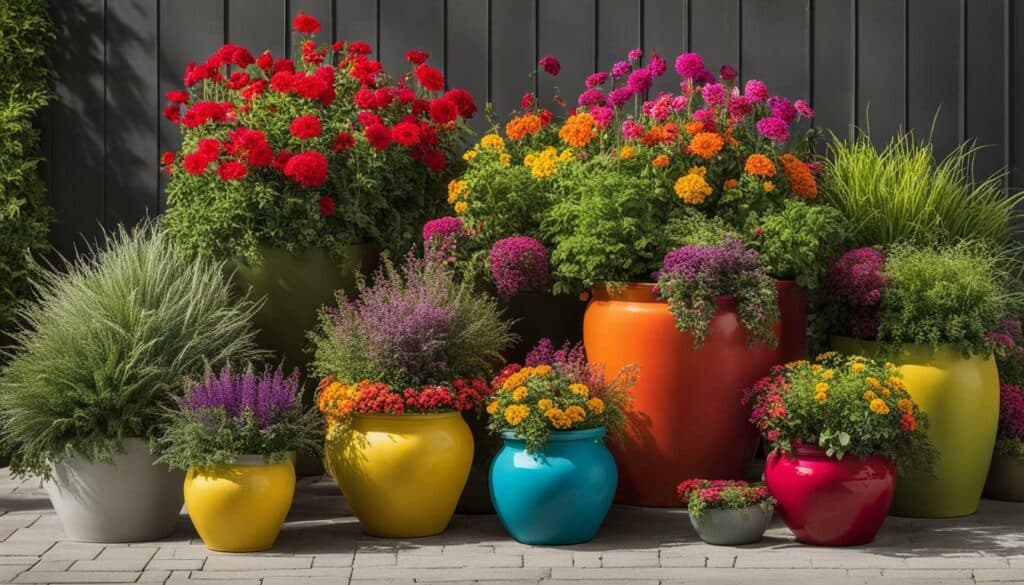
- Select containers of the appropriate size and with drainage holes.
- Choose a high-quality potting mix that suits your plants’ needs.
- Incorporate a slow-release fertilizer for long-lasting nutrition.
- Combine thrillers, fillers, and spillers for visually stunning displays.
- Water your containers regularly, ensuring they receive adequate moisture.
- Monitor your plants for pest and disease issues, taking prompt action when necessary.
- Rotate your containers periodically to ensure even sunlight distribution.
- Consider adding decorative elements such as trellises or stakes to support climbing plants.
By following these expert tips for container gardening, you can transform even the smallest of spaces into a vibrant and beautiful garden. Whether you want to cultivate a collection of herbs, grow colorful flowers, or create a focal point with a statement plant, container gardening offers endless possibilities for enhancing your restored garden.
Conclusion on Garden Restorations and Guide
Congratulations on completing Mastering Garden Restorations and Guide: Your Friendly Tutorial! Armed with the knowledge and inspiration you’ve gained, it’s time to embark on your garden restoration journey and create a haven of beauty and tranquility right in your own backyard.
Throughout this comprehensive guide, we’ve explored the essential steps for successful garden restoration. From assessing your garden’s needs and choosing the right materials and tools to creating a healing garden and reducing long-term maintenance, we’ve covered it all.
Remember the importance of conducting a thorough assessment of your garden and home, identifying problematic areas, and considering functionality and long-term goals. Research material options, compare prices, and opt for sustainable and eco-friendly choices.
Make use of the essential tools for your DIY projects and implement strategies to reduce long-term maintenance. Create a healing garden that promotes relaxation and well-being by incorporating hardscape, water features, and lighting. Attract wildlife, provide seating, and choose suitable plants that evoke memories and bring joy.
Don’t forget to take care of your garden through proper maintenance, including watering, dividing perennials, deadheading, and pruning. Learn the art of pruning, tailored to different types of plants, and explore the joy of growing your own tea. Consider container gardening as a versatile and convenient option for any space.
Congratulations once again on completing this guide. Now, armed with the knowledge and tips you’ve acquired, it’s time to put them into action and transform your garden into a beautiful and rejuvenating space.
FAQ on Garden Restorations and Guide
Q: What is Mastering Garden Restorations and Guide: Your Friendly Tutorial about?
A: Mastering Garden Restorations and Guide: Your Friendly Tutorial is a comprehensive manual that offers tips and techniques for budget-friendly garden and home renovations. It provides guidance on assessing renovation needs, choosing materials and tools, creating a healing garden, and reducing long-term maintenance.
Q: How can I assess my garden’s renovation needs?
A: To assess your garden’s renovation needs, start by conducting a thorough evaluation of the current state of your garden. Identify problematic areas, prioritize projects based on urgency and functionality, and consider your long-term goals for the space.
Q: What should I consider when choosing materials and tools for garden restoration?
A: When choosing materials and tools for garden restoration, it’s important to research different options, compare prices, and opt for sustainable and eco-friendly choices whenever possible. Consider the specific needs of your garden and the durability of the materials and tools you choose.
Q: How can I create a healing garden?
A: Creating a healing garden involves establishing goals, incorporating elements such as hardscape, water features, and lighting, attracting wildlife, providing seating, and selecting suitable plants. The guide provides in-depth insights and tips on how to create a tranquil and rejuvenating garden space.
Q: What are some tips for reducing long-term maintenance in my garden?
A: To reduce long-term maintenance in your garden, consider plant selection, plant rotation, starting plants from seeds, and implementing container gardening. The guide offers valuable advice on how to minimize the effort required to keep your garden healthy and thriving.
Q: How should I properly care for and maintain my garden?
A: Proper care and maintenance for a healthy garden include watering, dividing perennials, deadheading, and pruning. The guide provides detailed guidance on these essential tasks, taking into account different types of plants and their specific needs.
Q: What pruning techniques are recommended for different types of plants?
A: Pruning techniques can vary depending on the type of plant. The guide covers pruning techniques for fruit trees, trees and shrubs, ornamental plants, and flowering shrubs, providing step-by-step instructions for each.
Q: How can I grow my own tea in my restored garden?
A: Growing your own tea can be a rewarding experience. The guide offers guidance on selecting suitable tea plant varieties, cultivating and harvesting tea leaves, and preparing your own homemade tea.
Q: How can I create a wildlife-friendly garden?
A: Creating a wildlife-friendly garden involves attracting birds, butterflies, and other beneficial creatures by implementing specific elements and maintaining habitat diversity. The guide provides tips and suggestions on how to make your garden a haven for wildlife.
Q: How can I evoke memories through my garden?
A: Gardens have the power to evoke memories and emotions. The guide suggests incorporating personal elements and cherished plants that bring back fond memories, allowing your garden to become a place of nostalgia and reflection.
Q: What are some expert tips for successful container gardening?
A: Container gardening can be a practical and versatile solution. The guide offers expert tips on selecting the right container, choosing the best potting mix, selecting suitable plants, and proper fertilization and watering techniques to ensure successful container gardening.

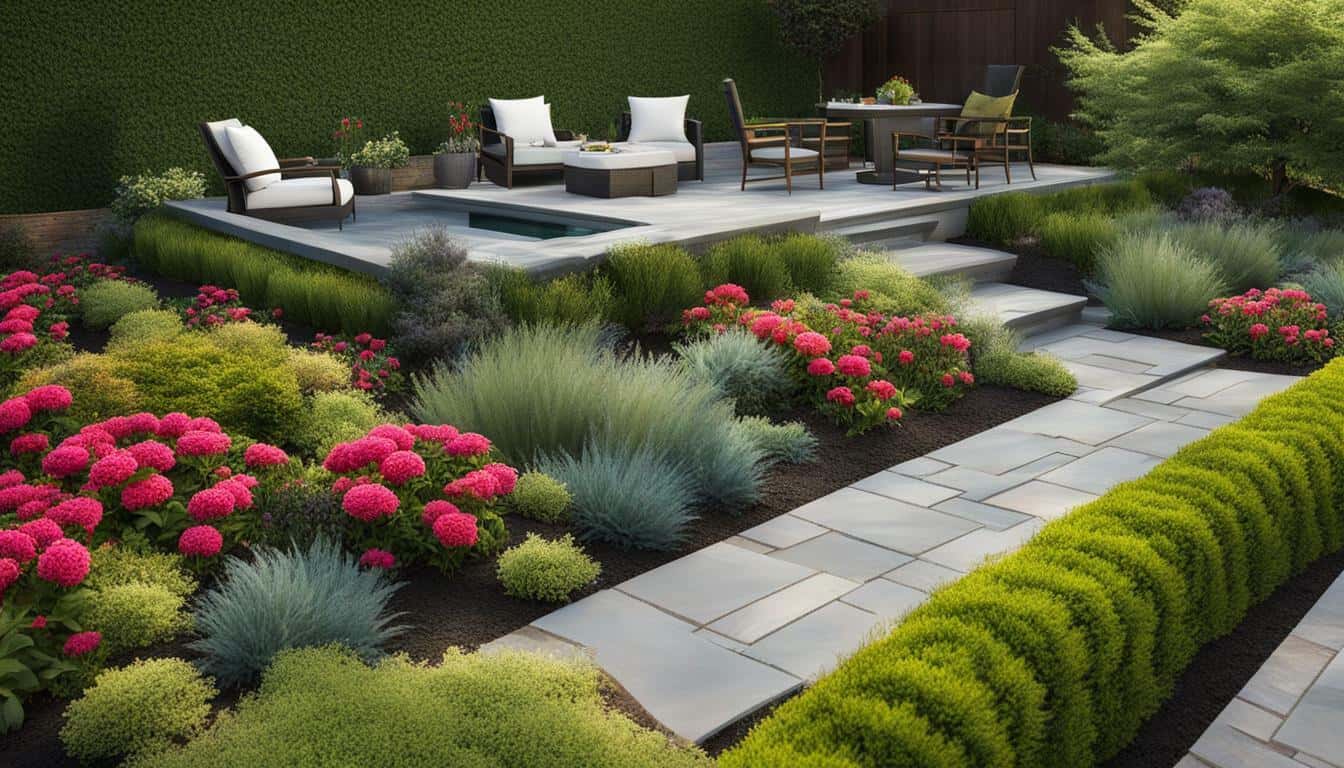



Leave a Reply